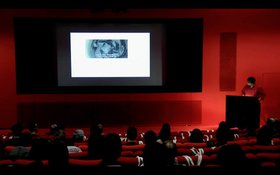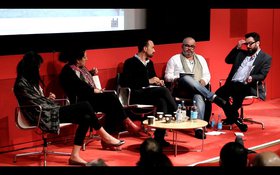News
Present Projections
Future Imperfect, A Symposium
Though the world seems caught in a complicated political, economic, and indeed, ideological crisis, the question of the day is simple: what does the future hold? This question underscored the discussions that took place at 'Future Imperfect', a symposium organized by Ibraaz in collaboration with Tate Modern and the Kamel Lazaar Foundation on 9 November 2013. The conference included a range of speakers, opening with a performance lecture by Shuddhabrata Sengupta of Raqs Media Collective, followed by a keynote lecture by Douglas Coupland.
In his lecture, which thought about the future as a ruin of the past, Sengupta proposed a self-organized future. He explained how memory and prophecy were 'two great allies' in the wider project of Raqs Media Collective, and how 'It doesn't matter if the past is weak or if prophecy is false,' either, since 'the future is our archive and the archive is our future.' Sengupta also reframed the notion of a 'state of emergency', choosing to focus on the contingency of emergence within such a situation, rather than the chaos that prompts such a state to be declared, or the imbalances of power that so often follow such declarations.
Sengupta's next points on swarm theory and the emergent senses of individualized being within a future collective were further developed by Douglas Coupland, who opened his keynote lecture with the assessment that the 'issue with the future is that we're not looking at human beings closely.' For Coupland, the difference between 1993 and 2013 was a certain kind of de-narration that has taken place since the shift from the analogue to digital era. As a result, Coupland concluded: 'the future loves you but doesn't need you,' which leaves us at another impasse when it comes to thinking about the road ahead, framed in questions put forward by Ibraaz Editor Anthony Downey during the conference's opening remarks: to whom does the future belong, and how do we claim it as our own?
In this, Todd Reisz's lecture expanded on Coupland and Sengupta's comments by exploring the framework of construction and design, within which the future is so often engineered and transmitted. Reisz questioned the assumption that architects shape our future through the notion of utopia and the ideals of modernity. Reisz referred to Thomas More's 1516 text Utopia and noted: 'Utopia comes from the past', and so do our future plans. Reisz used one case study: Aecom, one of the largest planning, engineering and design conglomerates in the world. He quoted an article from the corporation's magazine, One, that spoke about 'future proofing our world' so as to limit the risk of error and, essentially, failure. For Reisz, this could only mean one thing: future proofing was an insistence for, and affirmation of, a future blandness or 'future perfect,' produced both from and for a mass, complex system that leaves nothing to chance.
And herein lies our biggest folly when it comes to thinking about the future: we fear it, almost always because of the past, that spectre from which all future plans emerge. It was fitting, then, that the conference's first session, '1967/1968: What Was Lost?', (introduced by Ibraaz Senior Editor Omar Kholeif), focused on a key period in the history of the contemporary Arab world, the so-called Six Day War (an-Nakash or The Setback), which marked the end of the pan-Arab dream, not to mention 'the political will towards more open societies, economic growth, and the nascent cultural dispositions that marked the 1960s.' The events of 1967 were correlated to the movements that exploded in 1968 throughout Europe and Latin America, against state oppression, dictatorship and colonial rule.
Recognizing this period as a key yet problematic historical milestone often forgotten in our accelerated present, Anthony Downey talked to Joana Hadjithomas and Khalil Joreige about a project that essentially resurrected a lost or forgotten moment in Lebanese history at that time, The Lebanese Rocket Society (2012). The film tells the story of a group of students at the Armenian University in Lebanon who managed to design and build rockets throughout the sixties, and whose efforts captured the imagination of the nation in the process. In the discussion Joreige noted, when conducting a Google search on 'Lebanese rockets' before producing the film, he was directed to results of war, mainly related to the Israel-Lebanese conflict. However, since the film's extensive release and promotion, these searches are beginning to change to include the Lebanese Rocket Society and its legacies, pointing towards a re-writing, at least in part, of history and, by association, the future.
This idea of a certain kind of re-writing was continued in the following two presentations. The first was by artist Tony Chakar, who talked about the rationale behind One Hundred Thousand Solitudes (2012–present), an ongoing project that was, in Chakar's words, 'born from a profound solitude' he felt 'in front of [his] screen.' The project is both archival and archeological, in that it collects images from social media networks pertaining to revolutions and movements, including the civil war in Syria, and framing them within the context of a glimpse. Pointing to one image, of a protestor wearing a V mask (famous as a symbol for the Anonymous movement) playing an accordion, Chakar recalls the mediaeval depictions of carnival, 'when society was turned upside down.' It is this sense of the carnivalesque that Chakar sees in this image, noting: 'If we accept the assumption that every era dreams of the next one, then this would be a dream image.' For Chakar, such images are like 'ruptures or tears into the present', which provide brief and fleeting moments in which the future is made visible; a future that is already here, yet invisible most of the time. Such examples include a sign from Syria which reads: 'Down with the regime, the opposition, the Arab and Islamic nation, the world, everything', or a graffiti scrawl in Cairo which reads, 'may the whole world fall.'
Meanwhile, Tarek El Ariss returned to the year 1967 and described it as a 'scandal of Arab modernity', 'more catastrophic than 1948'. The reason offered was how Egypt's then-president, Gamal Abder Nasser, was somehow resurrected during this period, after he resigned following the Six-Day War only to be reinstated by popular demand. El Ariss compares this moment to the current 'Sisi mania', so-called since the surge in nationalist support for Egyptian army chief General Abdel Fattah al-Sisi, in which gender categories and identities have been employed for political purposes, including the notion of the virile, male leader.
For El Ariss, the issue with such collective narratives is how modernity in the Arab world has been experienced as a collapse, especially when such events are a result of encounters with the west. This has inadvertently produced a complicated crisis of national identity. In conclusion, El Ariss drew on the words of novelist Ahmed Alaidy, who stated in his novel, Being Abbas El-Abd (2006): 'You want us to progress? Burn the history books and forget your precious dead civilization.' In the end, perhaps the only way to move forward when so much has been lost, it to consecrate such collective experiences to the past.
Thus, a panel discussion that followed was perfectly titled: 'Structural Futures: Where to Now?' It was moderated by Anthony Downey, with speakers Lina Lazaar, a specialist in contemporary art at Sotheby's; artist Zineb Sedira, who runs Aria, an artist residency in Algiers; curator Abdelkader Damani, co-curator of the 2014 Dakar Biennale; and Omar Berrada, who co-directs Dar al-Ma'mun, an artist residency centre in Marrakech. The discussions focused on the work of each speaker, with attention paid to the specificity of the context of the Maghreb. Berrada talked about the idea of ruins in reverse, and the potential for experimenting with future audiences, while Sedira noted how, in Algiers, there was no issue with finding 'future audiences' but rather issues with finding support for independent, smaller projects that fall out of the state remit. For Lazaar, the problem with replicating western institutions when it comes to developing art scenes and infrastructures has been lessening, the result of, from her Tunisian perspective, the turbulent changes and urgencies brought on by the Arab uprisings of 2011 and their repercussions. Lazaar linked back to Sengupta when she noted that it was only through this state of emergency that independent initiatives have arisen and flourished. Indeed, for Damani, the key question of the twenty-first century is about the function of art itself: to whom it belongs and for whom it is working.
In closing, curator Bassam El Baroni offered his final thoughts on the day's discussions. Thinking about the failure of the institution and the rise of a new kind of thinking engendered by the Internet and the modes of communication and participation it has produced, Baroni touched on a present day conundrum: that 'we know we can't fit things into master narratives but we still think in master narratives.' Speaking about the palimpsest both as a way to view history and the way the Internet works, Baroni noted how, within the palimpsest, 'things continue; they shuffle their borders.' In thinking about this, the question of the future demands such forms: those that might respond to the granular complexity of common realities. Here, the necessity, according to Baroni, is a kind of radical contingency that essentially allows for a re-writing of everything we know.














